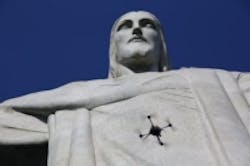UAVs create 3D model of Christ the Redeemer statue in Rio de Janeiro
Unmanned aerial vehicle (UAV) company Aeryon Labs Inc., together with Pix4D and PUC University of Rio de Janeiro, used a UAV and image processing software to create the first accurate 3D model of Brazil’s famous Christ the Redeemer monument.
MORE ARTICLES
FAA issues proposed rule on regulations for commercials UAVs
[Page 2] UAV roundup 2/9: The latest in unmanned aerial vehicle news
Vision-guided humanoid robot and UAV work in tandem to fight fires
Standing nearly 125 ft. tall and 92 ft. wide, Rio de Janeiro’s Christ the Redeemer statue is an imposing and impressive sight. Using a technology like LIDAR for 3D reconstruction is not possible, since it cannot scan the entire statue, due to size, location, accessibility, and weather. Prior to this project, all previous 3D models and replicas of the statue have been designed by hand.
Looking to create the first accurate 3D model of the monument, NEXT Lab of PUC University contacted image processing company Pix4D to determine if this could be achieved by using imaging software and UAVs. Up to the task, Pix4D contacted Aeryon Labs Inc. for data acquisition, while PUC’s NEXT Lab took on project logistics, including special permission to fly UAVs at the Christ the Redeemer heritage site.
For image acquisition, Aeryon equipped its Scout UAV—a vertical takeoff and landing quadrotor—with a customized imaging payload. A Ricoh WG-4 camera was integrated into a custom gimbal, and the camera and UAV were both controlled through a touchscreen tablet. Featuring a 1/2.3” 16 MPixel CMOS sensor, the Ricoh WG-4 camera is a waterproof, dustproof camera that is designed for “adventurous” outdoor applications. At full HD, the camera acquires images at 30 fps.
Images were collected by the customized Scout UAV for six consecutive mornings in late October, for a total of 3,584 images that were acquired during 19 separate ten-minute flights. Of these images, 2,090 of them were loaded into Pix4Dmapper Pro desktop software to convert them into the 3D model. The 3D reconstruction process was divided into three main parts: Statue, base, and surrounding area, and 9 sub-projects, to help manage the variations in image capture.
Page 1 | Page 2
About the Author

James Carroll
Former VSD Editor James Carroll joined the team 2013. Carroll covered machine vision and imaging from numerous angles, including application stories, industry news, market updates, and new products. In addition to writing and editing articles, Carroll managed the Innovators Awards program and webcasts.

